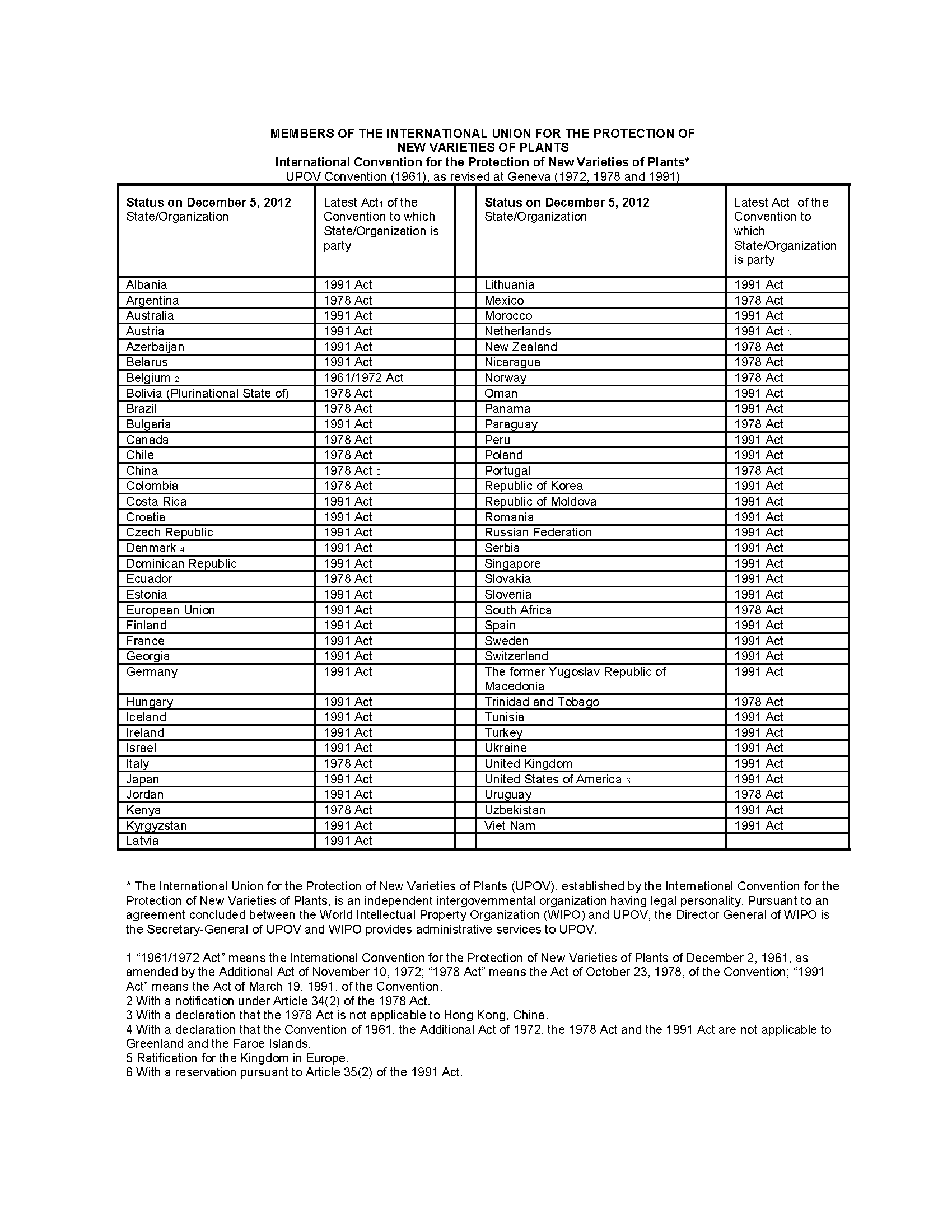1612 UPOV Convention [R-11.2013]
The International Convention for the Protection of New Varieties of Plants (generally known by its French acronym as "UPOV Convention") was adopted on December 2, 1961, by a Diplomatic Conference held in Paris.
The UPOV Convention has been revised on November 10, 1972, on October 23, 1978, and on March 19, 1991, in order to reflect technological developments in plant breeding and experience acquired with the application of the UPOV Convention. As of December 5, 2012, 71 states and organizations were party to the UPOV Convention.

Most states adhere to either the 1978 text or the 1991 text. The United States adheres to the 1991 text, and has a reservation under Article 35(2) of the text (which allows plant patents rather than breeder’s rights certificates to be granted).
The 1961, 1978, and 1991 texts guarantee to plant breeders in each member state both national treatment and the right of priority in all other member states. In many states, new plant varieties are protected by breeders’ rights laws rather than patent laws. Accordingly, the Paris (Industrial Property) Convention cannot always be relied on to provide these and other rights.
Insofar as the patenting of asexually reproduced plants in the United States is concerned, both national treatment and the right of priority have been accorded to foreign plant breeders since enactment of the plant patent law in 1930 (now 35 U.S.C. 161-164). See MPEP § 1613 for the right of priority based upon an application for plant breeder’s rights.
Application of the UPOV Convention in the United States does not affect the examination of plant patent applications, except in one instance. It is now necessary as a condition for receiving a plant patent to register a variety denomination for that plant. Inclusion of the variety denomination in the patent comprises its registration. The registration process in general terms consists of inclusion of a proposed variety denomination in the plant patent application. The examiner must evaluate the proposed denomination in light of UPOV Convention, Article 13. Basically, this Article requires that the proposed variety denomination not be identical with or confusingly similar to other names utilized in the United States or other UPOV member countries for the same or a closely related species. In addition, the proposed denomination must not mislead the average consumer as to the characteristics, value, or identity of the patented plant. Ordinarily, the denomination proposed for registration in the United States must be the same as the denomination registered in another member state of UPOV.
Pursuant to 37 CFR 1.76(b)(3), the Latin name and the variety denomination for the plant claimed may be included in an application data sheet (ADS). The Office, pursuant to the UPOV Convention, has been asked to compile a database of the plants patented and the database must include the Latin name and the variety denomination of each patented plant. Having this information in an ADS will make the process of compiling this database more efficient.
Form Paragraph 16.05 may be used to object to the disclosure as lacking a common or market name or “denomination” of the plant.
¶ 16.05 Name or Denomination for Plant Missing
The disclosure is objected to under 37 CFR 1.121(e) because no “variety denomination” of the instant plant has been set forth in the disclosure. 37 CFR 1.163(c)(4). Correction by adding such a name is required.
¶ 16.05.01 Latin Name of Genus and Species of the Plant Claimed Missing
The disclosure is objected to under 37 CFR 1.121(e) because the Latin name of the genus and species of the instant plant has not been set forth in the disclosure. 37 CFR 1.163(c)(4). Correction by adding such a name is required.

